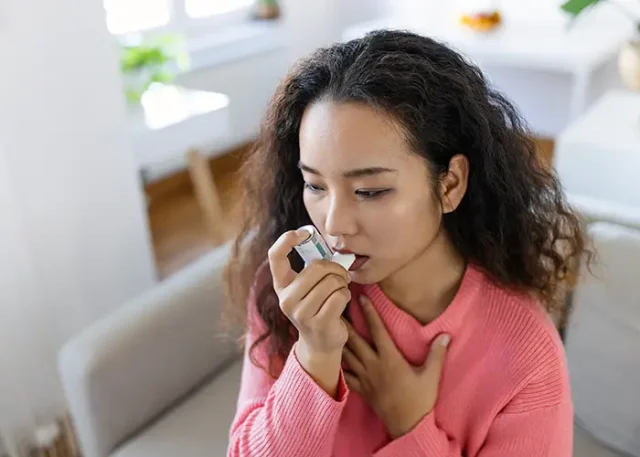
Traveling with asthma or allergies doesn’t have to mean stress, overpacking, or staying home “just in case.”
With a bit of planning, you can explore new cities, visit family, or take that long-awaited vacation without constantly worrying about your next breath.
This guide walks you through what to prepare before you go, what belongs in your carry-on “breathing kit,” how to make planes and hotel rooms more lung-friendly, and when it makes sense to travel with a portable nebulizer alongside your inhaler.
Why Planning Ahead Matters for Asthma & Allergies
Asthma and allergies are very sensitive to change – new climates, new pollen, new dust, new foods, new routines. Travel stacks all those changes together in a short time. That’s why planning ahead helps you:
- Avoid obvious triggers
- Keep your usual routine for meds and devices
- Know exactly what to do if symptoms start to worsen
Think of it this way: a 15–20 minute planning session at home can easily prevent a midnight pharmacy run in an unfamiliar city.
Pre-Trip Health & Paperwork Checklist
Before you pack clothes, do a quick health check. Book a short appointment with your doctor or asthma specialist 1–3 weeks before travel to confirm your asthma or allergies are stable, ask how climate or altitude might affect you, and update your written action plan.
Request a simple letter explaining your diagnosis, medications, and that you may carry inhalers or a nebulizer as medical devices.
Ask for extra prescriptions or refills in case a bag is lost or your trip runs long. Keep printed copies of your action plan and letter in your hand luggage, and store clear photos of them on your phone.
What Goes in Your Carry-On “Breathing Kit”
Your carry-on is your mobile breathing station. Anything essential to your lungs should stay with you, never in checked luggage.
Pack your controller inhaler, rescue inhaler, spacer, and regular allergy meds (tablets, nasal spray, eye drops), with enough for the trip plus a few extra days. Keep them together in one small pouch.
Add a “flare-up pouch” with your rescue inhaler, spacer, quick-acting allergy tablets (if advised), a copy of your action plan, and an emergency contact card.
Comfort items like a refillable water bottle and saline spray help with dry air. If you use nebulized medication, a compact, battery or USB-powered portable nebulizer for travel can fit here too.
Making Planes, Trains & Airports Easier on Your Lungs
Airports and cabins can be noisy, crowded, and very dry, which can irritate sensitive airways.
At security, keep meds in labeled packaging and your inhalers or nebulizer easy to reach; if asked, calmly explain it’s a medical device and show your doctor’s letter.
Onboard, keep your rescue inhaler where you can grab it without standing up and sip water regularly to counter dry air.
A simple mask can help if you’re worried about viruses, strong scents, or cleaning chemicals. If you need to use a portable nebulizer, choose a calm moment, stay seated, and follow crew instructions. On trains and buses, the same principles apply: access, hydration, and awareness of your triggers.
Hotel & Airbnb Hacks for Cleaner Air
Where you sleep can shape how you feel the next day. When choosing a hotel or Airbnb, prioritize smoke-free properties and, if dust is a major trigger, rooms with hard floors over wall-to-wall carpet.
Before arrival, you can message the property to request no strong air fresheners or heavy fragrances in your room.
On arrival, briefly air out the room if windows open safely; if the smell is smoky or overpowering, ask politely for another room. During cold and flu season, some guests like to wipe high-touch surfaces.
For dust mites, consider a lightweight pillow encasement or travel pillow and keep luggage off the bed. Adjust housekeeping frequency if daily cleaning stirs up symptoms.
Inhaler Only vs. Inhaler Plus Portable Nebulizer
Inhalers, especially when used with a spacer, are usually the first-choice way of delivering asthma medication.
They are fast, small, and easy to carry in a pocket or small bag, which makes them ideal for flights and day trips.
For many people, an inhaler and a written action plan are enough to manage symptoms confidently while traveling.
However, some people also use nebulized medication at home, particularly during flare-ups, chest infections, or bad allergy seasons. The question then becomes whether to change that routine while traveling or to bring a nebulizer along.
| Aspect | Inhaler Only | Inhaler + Portable Nebulizer |
| Main role | Everyday control and quick relief | Mirrors your home “sick-day” or flare-up plan while you’re traveling |
| Best for | People with good inhaler technique and mild–moderate flare | People who struggle with inhaler timing or need nebulized meds during bad days |
| Travel convenience | Ultra-small, fits in any pocket or pouch | Still travel-friendly if you choose a compact, lightweight, quiet mesh device |
| When especially useful | Short trips, city breaks, easy access to clinics | Longer or remote trips, recent chest infections, severe allergy/asthma seasons |
| Power & setup | No power needed; use with a spacer | Look for USB or battery power and simple assembly/cleaning (important when jet-lagged) |
| Example device option | Any reliever + spacer recommended by your clinician | TruNeb™ Portable Mesh Nebulizer – pocket-size, quiet, USB-rechargeable |
Your Travel Breathing Checklist
To make planning easier, here is a simple table you can use as a starting point and adapt to your own needs:
| Scenario | Must-Haves in Reach (Carry-On / Day Bag) | Good-to-Have in Suitcase / Room |
| Airport & Flight | Rescue inhaler + spacer, action plan copy, water bottle, tissues, mask | Extra controllers, extra rescue inhaler, spare spacer |
| Long City Day (Sightseeing / Tour) | Rescue inhaler, small flare-up pouch, allergy tablets (if prescribed), saline | Extra meds in hotel safe, comfortable mask, extra saline |
| Remote or Nature Trips | Rescue inhaler, compact first-aid kit, portable nebulizer (if prescribed) | Extra nebulizer mouthpiece/mask, small cleaning kit, backup charger |
| Hotel / Airbnb Stay | Rescue inhaler on bedside, action plan, portable nebulizer if you use one | Pillow cover, backup meds, small wipes or cleaner |
| Travel with Kids | Kid’s inhaler + spacer, favorite comfort item, doctor’s letter, snacks | Child-size masks, extra clothes/bedding, small toys/books |
Do I really need a portable nebulizer if I already have an inhaler?
Not everyone does. Many people travel just fine with an inhaler and spacer alone. If that’s how you usually manage your symptoms, your doctor may say that’s enough.
But if your home action plan includes nebulized treatments during flare-ups or when you’re sick, bringing a portable nebulizer helps you follow the same plan on the road instead of guessing.
A simple way to ask your doctor is: “When I travel, is my inhaler and spacer enough, or should I also take my nebulizer?”
How do I clean a nebulizer while traveling?
Keep the routine simple and consistent with the manual. Wash your hands first. After each treatment, rinse the medicine cup and mouthpiece or mask with clean water and let them air dry.
Once a day, wash the removable parts in warm, soapy water, rinse well, and dry completely on a clean towel.
Never put the main electronic unit in water. Before you go, read your device’s instructions and pack just the basics: a small gentle soap and a clean cloth.
What if I have an asthma flare in a country where I don’t speak the language?
Prepare a short note or phone screen that says “I have asthma” and “I need a doctor” in the local language. Keep photos of your medications and action plan to show staff or doctors.
When you check in, ask your hotel or host to mark the nearest clinic and emergency department on a map.
If you enter the “red zone” in your action plan – severe breathlessness, trouble speaking, or no relief from your inhaler – follow your emergency instructions and seek help immediately.
Is it safe to travel if I had a serious flare-up recently?
That decision has to come from your own clinician. Recent hospital stays, very frequent rescue inhaler use, or ongoing severe symptoms usually mean your asthma isn’t well controlled and travel could be risky, especially long flights or remote trips.
Be honest about how you’ve been feeling, and let your doctor decide whether to delay the trip, adjust your treatment, or add extra precautions. It’s better to wait a bit than face another major attack far from home.





